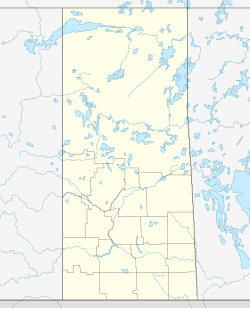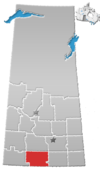world.wikisort.org - Canada
Wood Mountain (2016 population: 20) is a village in the Canadian province of Saskatchewan within the Rural Municipality of Old Post No. 43 and Census Division No. 3. Its name is derived from the Red River Métis words "montagne de bois" (meaning mountain of wood in French), due to the abundance of poplar trees in the otherwise barren region. Highway 18 and Highway 358 intersect south of the community.
Wood Mountain | |
|---|---|
Village | |
 Saskatchewan Wheat Pool elevator | |
 Wood Mountain  Wood Mountain | |
| Coordinates: 49°22′15″N 106°23′01″W | |
| Country | Canada |
| Province | Saskatchewan |
| Region | South-central |
| Rural Municipality | Old Post |
| Incorporated (village) | 1930 |
| Government | |
| • Governing body | Wood Mountain Village Council |
| • Mayor | Edward McIvor |
| • Clerk | Sherry Mielke |
| • MLA | Dave Marit |
| • MP | Jeremy Patzer |
| Area | |
| • Total | 0.61 km2 (0.24 sq mi) |
| Population (2006) | |
| • Total | 20 |
| • Density | 32.6/km2 (84/sq mi) |
| Time zone | CST |
| Postal code | S0H 4L0 |
| Area code | 306 |
| Highways | Highway 18 Highway 358 |
| Railways | Canadian Pacific Railway (Defunct) |
| Website | Village of Wood Mountain[1] |
| [2][3][4][5] | |
Wood Mountain is known for its annual stampede that has been held every year for more than 120 years.
This village is home to the First Nations administrative office for the band government of the Wood Mountain Lakota First Nation.[6]
History
Wood Mountain was the terminus of the Fort Ellice-Wood Mountain Trail that was used from 1757 to the 1850s to haul provisions such as pemmican by the Metis and First Nations. The trail was over 400 kilometres long.[7] It incorporated as a village on March 4, 1930.[8]
Demographics

In the 2021 Census of Population conducted by Statistics Canada, Wood Mountain had a population of 20 living in 8 of its 14 total private dwellings, a change of 0% from its 2016 population of 20. With a land area of 0.61 km2 (0.24 sq mi), it had a population density of 32.8/km2 (84.9/sq mi) in 2021.[11]
In the 2016 Census of Population, the Village of Wood Mountain recorded a population of 20 living in 9 of its 10 total private dwellings, a -25% change from its 2011 population of 25. With a land area of 0.61 km2 (0.24 sq mi), it had a population density of 32.8/km2 (84.9/sq mi) in 2016.[12]
Economy and tourism
Historically, Wood Mountain's economy has relied mainly on the agriculture industry. The community still has strong roots to farming and ranching, but with its location and rich history, tourism has become a main industry. The community has accommodations, such as hotels and bed and breakfasts,[13] a cafe restaurant, pool, library, community hall, churches, museums, campgrounds, and parks.
Local attractions
- Wood Mountain Regional Park[14]
- Wood Mountain Rodeo & Ranching Museum (located at Wood Mountain Regional Park)
- Wood Mountain Community Pool
- Wood Mountain Post Historic Park[15]
Events
- Wood Mountain Stampede, oldest continuous annual Rodeo in Canada. It is located at Wood Mountain Regional Park and has run since 1890.[16]
- Wood Mountain Farmers Market
Regional attractions/accommodations
- Grasslands National Park
- St. Victor Petroglyphs Provincial Historic Park
- Thomson Lake Regional Park
Notable residents
- Andrew Suknaski, poet
- Kacy & Clayton, folk-rock group
See also
- List of communities in Saskatchewan
References
- Village of Wood Mountain
- National Archives, Archivia Net. "Post Offices and Postmasters".
- Government of Saskatchewan, MRD Home. "Municipal Directory System". Archived from the original on November 21, 2008.
- Canadian Textiles Institute. (2005). "CTI Determine your provincial constituency".
- Commissioner of Canada Elections, Chief Electoral Officer of Canada (2005). "Elections Canada On-line".
- "Wood Mountain First Nation". Archived from the original on April 2, 2015. Retrieved March 28, 2015.
- "The Encyclopedia of Saskatchewan | Details".
- "Urban Municipality Incorporations". Saskatchewan Ministry of Government Relations. Archived from the original on October 15, 2014. Retrieved June 1, 2020.
- "Saskatchewan Census Population" (PDF). Saskatchewan Bureau of Statistics. Archived from the original (PDF) on September 24, 2015. Retrieved May 31, 2020.
- "Saskatchewan Census Population". Saskatchewan Bureau of Statistics. Retrieved May 31, 2020.
- "Population and dwelling counts: Canada, provinces and territories, census divisions and census subdivisions (municipalities), Saskatchewan". Statistics Canada. February 9, 2022. Retrieved April 1, 2022.
- "Population and dwelling counts, for Canada, provinces and territories, and census subdivisions (municipalities), 2016 and 2011 censuses – 100% data (Saskatchewan)". Statistics Canada. February 8, 2017. Retrieved May 30, 2020.
- "Limerick Hotel Licensed Dining Room | Tourism Saskatchewan".
- "Wood Mountain Regional Park". Tourism Saskatchewan. Government of Saskatchewan. Retrieved October 6, 2022.
- "Wood Mountain Post Provincial Historic Park". Tourism Saskatchewan. Government of Saskatchewan. Retrieved October 6, 2022.
- "The Wood Mountain Stampede".
External links
Другой контент может иметь иную лицензию. Перед использованием материалов сайта WikiSort.org внимательно изучите правила лицензирования конкретных элементов наполнения сайта.
WikiSort.org - проект по пересортировке и дополнению контента Википедии
